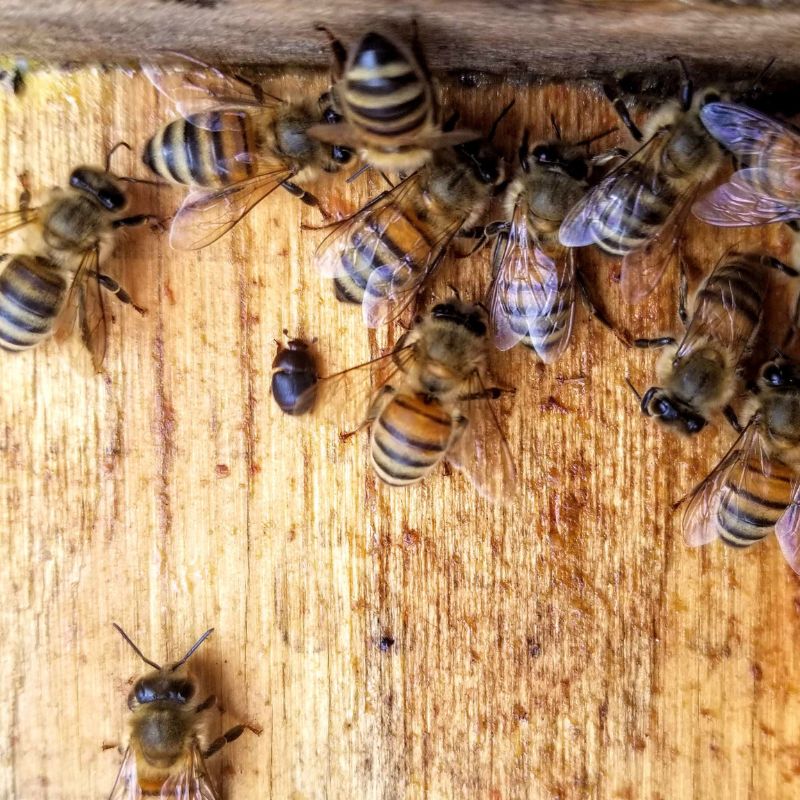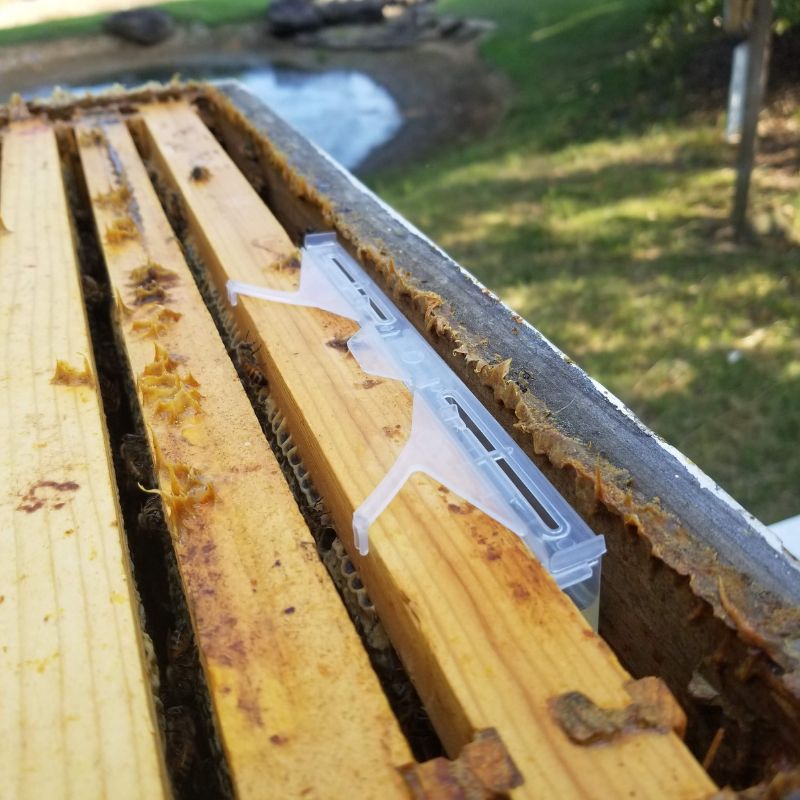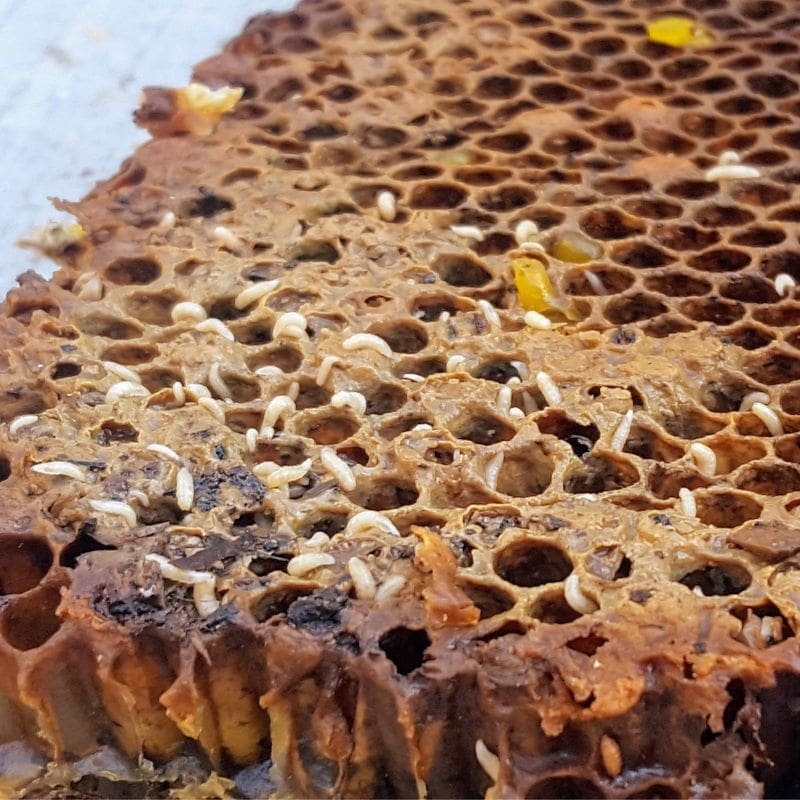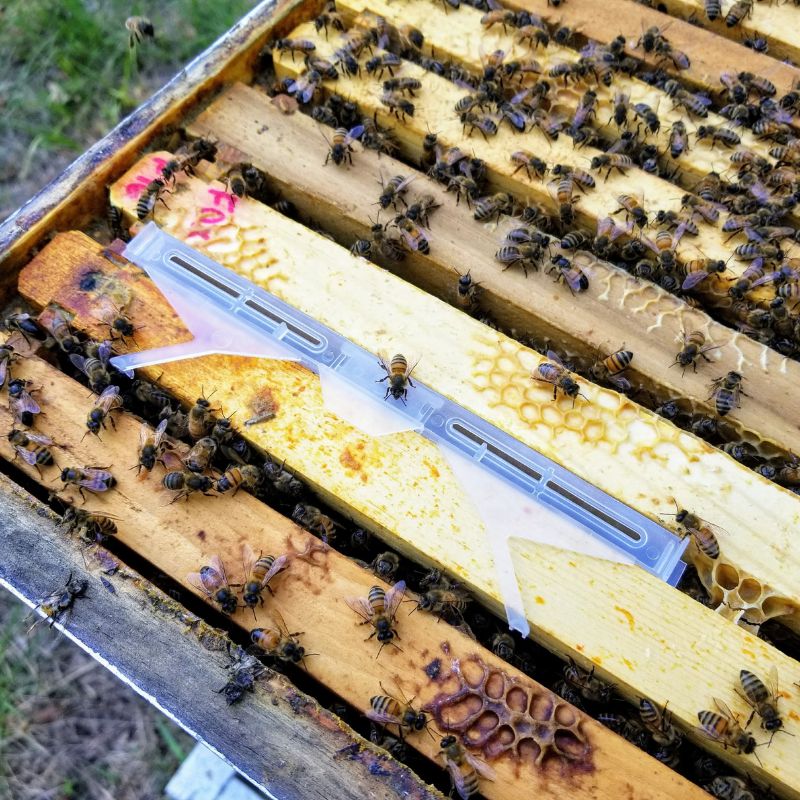

Small hive beetles can be a real problem for beehives and can wreak havoc on the health of a colony. Although most honeybees can keep their numbers low and keep an infestation from happening, the beekeeper can help to keep their numbers low with the Beetle Jail. Small hive beetles may not pose a serious threat at first, but they can become problematic over time.
This often happens with a weak or queen-less hive. Typically, the beetles have plenty of opportunities to lay eggs in the comb during this time. Stronger colonies deal with these easily, but on the other hand, smaller and weaker ones are more susceptible to hive beetles. The presence of beetle traps such as beetle jails helps in controlling their numbers and catching them before they can lay, multiply, and threaten colonies.
Small hive beetles can be a real problem for beehives and can wreak havoc on the health of a colony. Although most honeybees can keep their numbers low and keep an infestation from happening, the beekeeper can help to keep their numbers low with the Beetle Jail. Small hive beetles may not pose a serious threat at first, but they can become problematic over time.
This often happens with a weak or queen-less hive. Typically, the beetles have plenty of opportunities to lay eggs in the comb during this time. Stronger colonies deal with these easily, but on the other hand, smaller and weaker ones are more susceptible to hive beetles. The presence of beetle traps such as beetle jails helps in controlling their numbers and catching them before they can lay, multiply, and threaten colonies.
Table of Contents
Table of Contents
Small Hive Beetles Can Multiple Quickly
Small Hive Beetles Can Multiple Quickly
Small hive beetle populations multiply at an alarming rate and can even cause problems that may lead to honeybees completely absconding from the beehive. The adult hive beetles aren’t the ones that actually cause the most damage. Small hive beetle larva is the ones that can actually slime out a colony, making it unsuitable for the colony to live in. This results in the fermentation of honey, which can prompt honeybees to leave because of stress. It’s really pretty disgusting, so you don’t want that to happen.
Small hive beetles can fly for miles. They usually increase in population during the summer months. In addition to natural population growth, their numbers depend on where you’re located. Colonies in the southern US have more issues than colonies in the northern US. This is because the reproduction cycle of beetles mimics coincides with the weather. The longer the summer months, the more opportunities beetles have to reproduce.
These types of pests are unavoidable for some keepers. Hive beetle management is essential to ensure the safety of your honeybees and one of the most effective ways to control small hive beetles is through the usage of beetle jail.
Small hive beetle populations multiply at an alarming rate and can even cause problems that may lead to honeybees completely absconding from the beehive. The adult hive beetles aren’t the ones that actually cause the most damage. Small hive beetle larva is the ones that can actually slime out a colony, making it unsuitable for the colony to live in. This results in the fermentation of honey, which can prompt honeybees to leave because of stress. It’s really pretty disgusting, so you don’t want that to happen.
Small hive beetles can fly for miles. They usually increase in population during the summer months. In addition to natural population growth, their numbers depend on where you’re located. Colonies in the southern US have more issues than colonies in the northern US. This is because the reproduction cycle of beetles mimics coincides with the weather. The longer the summer months, the more opportunities beetles have to reproduce.
These types of pests are unavoidable for some keepers. Hive beetle management is essential to ensure the safety of your honeybees and one of the most effective ways to control small hive beetles is through the usage of beetle jail.
Beetle Jails Help Keep Beetle Populations Low
Beetle Jails Help Keep Beetle Populations Low
Beetle jails are reusable and practical traps for small hives and very effective for preventing infestations. Beetle jails are easy-to-use and feature a bait compartment that draws small hive beetles. These traps have flaps that are conveniently placed on top of a frame. If this trap is filled with small hive beetles, you can reuse them by cleaning and discarding the beetles that are trapped.
A beetle jail is made from recyclable polypropylene plastic that has small tabs on end. You can even easily pry it off the frame without opening the lid by using a hive tool. There are many ways to control small hive beetles, and using a beetle jail is one of the most simple yet inexpensive ways.
Small hive beetles usually seek out colonies for easy access to food and protection. Also, they are strong fliers and are quite the persistent pests. Exterminating them completely will be difficult. It is essential to control their population by using beetle traps before the spring and summer months when the pests multiply quickly in numbers.
Beetle jails are reusable and practical traps for small hives and very effective for preventing infestations. Beetle jails are easy-to-use and feature a bait compartment that draws small hive beetles. These traps have flaps that are conveniently placed on top of a frame. If this trap is filled with small hive beetles, you can reuse them by cleaning and discarding the beetles that are trapped.
A beetle jail is made from recyclable polypropylene plastic that has small tabs on end. You can even easily pry it off the frame without opening the lid by using a hive tool. There are many ways to control small hive beetles, and using a beetle jail is one of the most simple yet inexpensive ways.
Small hive beetles usually seek out colonies for easy access to food and protection. Also, they are strong fliers and are quite the persistent pests. Exterminating them completely will be difficult. It is essential to control their population by using beetle traps before the spring and summer months when the pests multiply quickly in numbers.
Advantages Of Using A Beetle Jail
Advantages Of Using A Beetle Jail
The use of a beetle jail is practical because most beekeepers find them easier to clean. One of the features that set beetle jails apart from the others is its inner bait compartment. This inner bait compartment has a separate lid that does not allow any beetles to enter. The small hive beetle, however, can smell the bait, be enticed to approach, and enter the trap.
The beetle jail has a lid with a small barrier on the ends that form a recessed pocket. They look for a place to hide, go down into the pocket and entrance slots. Hive beetles love to hide in groups and can usually be found in corners. Honeybees also help keep the small beetles away by driving them to specific areas. This characteristic is really the reason that Beetle Jails work well.
These areas should be noted as they will determine the best placement for using beetle jails. Most of the beetles in the hive are hiding in the top 4 corners and the bottom 4 corners of the hive. In these top corners, you’ll have the best success at trapping beetles with a beetle jail. Beetle Jails are fairly tough and can be used for several years. They are less expensive and more narrow in size compared to beetle blasters, allowing them to fit well between the outside frame and the box. The beetle jail stays put and doesn’t fall off easily. They can also be used without a lure but by adding a lure, you capture more quicker.
The use of a beetle jail is practical because most beekeepers find them easier to clean. One of the features that set beetle jails apart from the others is its inner bait compartment. This inner bait compartment has a separate lid that does not allow any beetles to enter. The small hive beetle, however, can smell the bait, be enticed to approach, and enter the trap.
The beetle jail has a lid with a small barrier on the ends that form a recessed pocket. They look for a place to hide, go down into the pocket and entrance slots. Hive beetles love to hide in groups and can usually be found in corners. Honeybees also help keep the small beetles away by driving them to specific areas. This characteristic is really the reason that Beetle Jails work well.
These areas should be noted as they will determine the best placement for using beetle jails. Most of the beetles in the hive are hiding in the top 4 corners and the bottom 4 corners of the hive. In these top corners, you’ll have the best success at trapping beetles with a beetle jail. Beetle Jails are fairly tough and can be used for several years. They are less expensive and more narrow in size compared to beetle blasters, allowing them to fit well between the outside frame and the box. The beetle jail stays put and doesn’t fall off easily. They can also be used without a lure but by adding a lure, you capture more quicker.
Baits You Can Use For Your Beetle Jail
Baits You Can Use For Your Beetle Jail
Choosing the baits for your beetle jail can help you catch beetles more efficiently. Putting in baits can upgrade the effectiveness of your beetle jail, but it will still work well without a bait. Before you fit the beetle jail into the frames, the two outside compartments should be filled halfway with inexpensive cooking oil, diatomaceous earth, or boric acid.
There is some new developments on using a mixture of pollen patties and hydrogen peroxide that is toxic to small hive beetle adults, but not toxic to honey bees. This mixture can be placed inside the beetle jail for the beetles to ingest.
The beetle jail has openings that allow beetles to enter easily and trap them inside. Healthy hives help in forcing these beetles into these traps. The lure doesn’t actually trap the beetles, but only encourages them to come close to the trap. The later in the year these traps are used, the more likely they are to be propolized. After summer ends, these traps are removed and stored for the following year. They do not need to be left in the colony year around.
https://www.youtube.com/watch?v=mTGdWmh_ADo&t=1s
Choosing the baits for your beetle jail can help you catch beetles more efficiently. Putting in baits can upgrade the effectiveness of your beetle jail, but it will still work well without a bait. Before you fit the beetle jail into the frames, the two outside compartments should be filled halfway with inexpensive cooking oil, diatomaceous earth, or boric acid.
There is some new developments on using a mixture of pollen patties and hydrogen peroxide that is toxic to small hive beetle adults, but not toxic to honey bees. This mixture can be placed inside the beetle jail for the beetles to ingest.
The beetle jail has openings that allow beetles to enter easily and trap them inside. Healthy hives help in forcing these beetles into these traps. The lure doesn’t actually trap the beetles, but only encourages them to come close to the trap. The later in the year these traps are used, the more likely they are to be propolized. After summer ends, these traps are removed and stored for the following year. They do not need to be left in the colony year around.
https://www.youtube.com/watch?v=mTGdWmh_ADo&t=1s
Lure Options For Your Beetle Jail
Lure Options For Your Beetle Jail
Some common lures that are used by beekeepers are apple cider, vinegar, and other ripe fruits are effective as hive beetles are attracted to fermented fruit.
Remember to close the bait compartment lid before closing the main lid. These Beetle Jail traps are designed to be hung from frames, so the ideal spot to place them is in the four corners of the top box. Beetle jails are also designed to be used in a Langstroth hive. Because of their slim size, the traps fit well and do not disturb your honeybees when placed on between the frames.
Some common lures that are used by beekeepers are apple cider, vinegar, and other ripe fruits are effective as hive beetles are attracted to fermented fruit.
Remember to close the bait compartment lid before closing the main lid. These Beetle Jail traps are designed to be hung from frames, so the ideal spot to place them is in the four corners of the top box. Beetle jails are also designed to be used in a Langstroth hive. Because of their slim size, the traps fit well and do not disturb your honeybees when placed on between the frames.
Placement Of Your Beetle Jail Is Important
Placement Of Your Beetle Jail Is Important
Placing the beetle jail is vital because it can affect the number of small hive beetles that can be trapped. Beetle jail traps are designed to fit between the box and the frame, so this is the best place to put them. You will catch fewer beetles if you place the traps between the frames compared to between the frame and the box. Placing the trap between the frames will also create a gap between them, affecting the “bee space” between the frames.
You can place one trap in each corner of the top box, which is the ideal setup. During the summer, there is a chance that hive beetle populations will increase so it is best to use the traps early in the summer to keep beetle levels low.
The small hive beetles will typically be pushed to the corners of the hive, including the top and bottom corners. When you place the traps in the hive for the first time, it may be necessary to scrape the area clean of propolise or comb. The number of beetle jail traps depend on what you observe within the hive. If there are a lot of beetles, then you will need 4 traps in the top box.
Twitter
LinkedIn
Facebook
Pinterest
StumbleUpon
Reddit
Placing the beetle jail is vital because it can affect the number of small hive beetles that can be trapped. Beetle jail traps are designed to fit between the box and the frame, so this is the best place to put them. You will catch fewer beetles if you place the traps between the frames compared to between the frame and the box. Placing the trap between the frames will also create a gap between them, affecting the “bee space” between the frames.
You can place one trap in each corner of the top box, which is the ideal setup. During the summer, there is a chance that hive beetle populations will increase so it is best to use the traps early in the summer to keep beetle levels low.
The small hive beetles will typically be pushed to the corners of the hive, including the top and bottom corners. When you place the traps in the hive for the first time, it may be necessary to scrape the area clean of propolise or comb. The number of beetle jail traps depend on what you observe within the hive. If there are a lot of beetles, then you will need 4 traps in the top box.
Twitter
LinkedIn
Facebook
Pinterest
StumbleUpon
Reddit
Do’s And Don’ts To Avoid Attracting Small Hive Beetles
Do’s And Don’ts To Avoid Attracting Small Hive Beetles
Don’t spill oil inside the colony when adding the traps to the hive.
Use food-grade oil in the traps so to keep anything unsafe from getting near your honey.
Don’t forget about the traps inside the hive; if they are plugged up with propolise, clean them out.
Do put them in the right location inside the hive.
Don’t put a trap in every box in the hive, this isn’t necessary and is ineffective.
When you add an additional box to the hive, move the traps up to the new box.
Don’t spill oil inside the colony when adding the traps to the hive.
Use food-grade oil in the traps so to keep anything unsafe from getting near your honey.
Don’t forget about the traps inside the hive; if they are plugged up with propolise, clean them out.
Do put them in the right location inside the hive.
Don’t put a trap in every box in the hive, this isn’t necessary and is ineffective.
When you add an additional box to the hive, move the traps up to the new box.
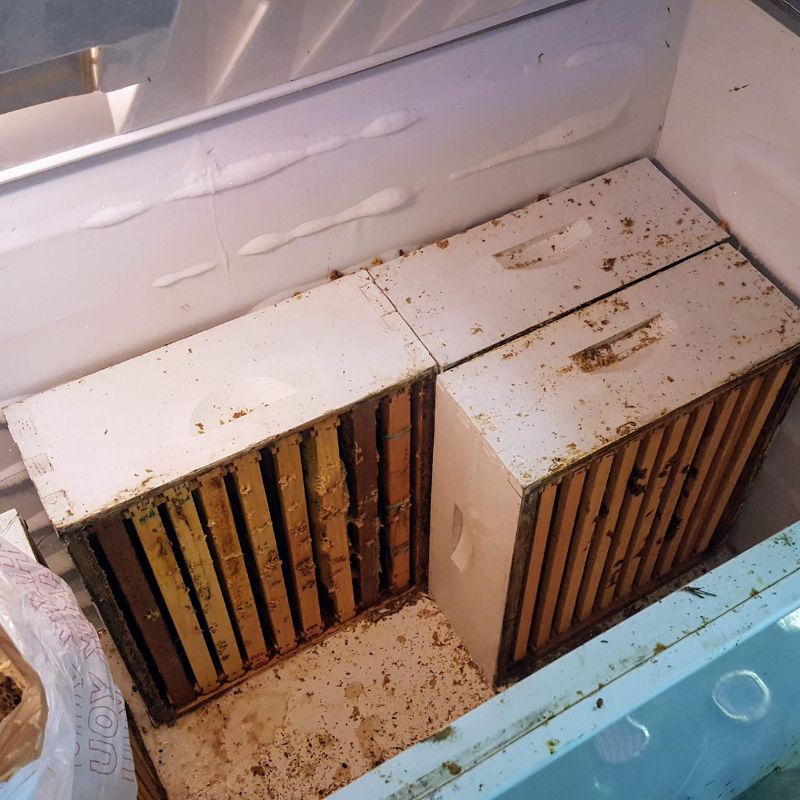
Other Options For Beetle Control
Other Options For Beetle Control
There are other options for dealing with hive beetles that we can recommend. Not all products work perfectly for every situation, but there are some good ones.
If you have a bad infestation of beetles, sometimes the in-hive beetle traps like the Beetle Jail, Beetle Blaster, and Foxhound Beetle Trap may not do the job. There is an oil pan that slides under the screened bottom board of the hive. This is the best tool for dealing with small hive beetles stressing the colony. They only work with our screened bottom board because they are custom-made for us. The beetles are forced through the screen of the hive and into the oil. They work the same way as the beetle traps in the hive, but they can kill thousands of beetles instead of hundreds.
The other traps available are in hive traps and Swiffer towels. See all the other beetle trap options here.
There are other options for dealing with hive beetles that we can recommend. Not all products work perfectly for every situation, but there are some good ones.
If you have a bad infestation of beetles, sometimes the in-hive beetle traps like the Beetle Jail, Beetle Blaster, and Foxhound Beetle Trap may not do the job. There is an oil pan that slides under the screened bottom board of the hive. This is the best tool for dealing with small hive beetles stressing the colony. They only work with our screened bottom board because they are custom-made for us. The beetles are forced through the screen of the hive and into the oil. They work the same way as the beetle traps in the hive, but they can kill thousands of beetles instead of hundreds.
The other traps available are in hive traps and Swiffer towels. See all the other beetle trap options here.

